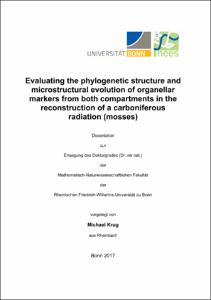Krug, Michael: Evaluating the phylogenetic structure and microstructural evolution of organellar markers from both compartments in the reconstruction of a carboniferous radiation (mosses). - Bonn, 2017. - Dissertation, Rheinische Friedrich-Wilhelms-Universität Bonn.
Online-Ausgabe in bonndoc: https://nbn-resolving.org/urn:nbn:de:hbz:5n-48453
Online-Ausgabe in bonndoc: https://nbn-resolving.org/urn:nbn:de:hbz:5n-48453
@phdthesis{handle:20.500.11811/7267,
urn: https://nbn-resolving.org/urn:nbn:de:hbz:5n-48453,
author = {{Michael Krug}},
title = {Evaluating the phylogenetic structure and microstructural evolution of organellar markers from both compartments in the reconstruction of a carboniferous radiation (mosses)},
school = {Rheinische Friedrich-Wilhelms-Universität Bonn},
year = 2017,
month = sep,
note = {In the reconstruction of the plant tree of life, sequence data from the plastid genome is currently favored as it contains a mixture of coding and noncoding regions, spanning different patterns of substitution rates and thus serving various scientific approaches, from large-scale phylogenies to population genomics. Most interestingly, the fast evolving noncoding regions of plastid origin have been shown to be a powerful phylogenetic tool not only in in shallow levels of angiosperm phylogenetics, but also at deep levels (Barniske et al., 2012; Borsch and Quandt, 2009), as a result of a more equitable distribution of phylogenetic information due to low selective constraints (Barniske et al., 2012; Müller et al., 2006). But is intrinsic and common to both organellar compartments? Thus are both compartments evolving in a similar fashion in terms of substitution rate and microstructural evolution which leads to a comparable phylogenetic structure? As the structural integrity of the chondrome is abandoned early in tracheophyte evolution (e.g. Palmer and Herbon 1988; Kubo and Mikami 2007; Grewe et al. 2009) a direct comparision is only feasible in one of the bryophyte lineages which at the same time extends the deep level phylogenetic to 500 MYA. Therefore, a balanced data set of plastome and chondrome data spanning spacers, introns and genes was compiled for a representative set of mosses, a dataset that also roots in previous studies that aimed to resolve the difficult backbone phylogeny of mosses.
Most importantly, the data now allows resolving crucial nodes with significance, that were not confidently resolved in other studies. At the same time the evolutionary history of peristomes as a crucial distinguishing feature in moss systematics could be traced in a geological time line, including shifts in speciation rates of these lineages. Furthermore, it allows quantifying and comparing the phylogenetic structure in different phylogenetic markers from mitochondrial and plastid DNA. Finally, a survey on the phylogenetic properties of different types of insertion and deletions (indels), namely simple sequence repeats, hairpin associated inversions and all other indels evaluates the peculiarities in each type and their phylogenetic impact.},
url = {https://hdl.handle.net/20.500.11811/7267}
}
urn: https://nbn-resolving.org/urn:nbn:de:hbz:5n-48453,
author = {{Michael Krug}},
title = {Evaluating the phylogenetic structure and microstructural evolution of organellar markers from both compartments in the reconstruction of a carboniferous radiation (mosses)},
school = {Rheinische Friedrich-Wilhelms-Universität Bonn},
year = 2017,
month = sep,
note = {In the reconstruction of the plant tree of life, sequence data from the plastid genome is currently favored as it contains a mixture of coding and noncoding regions, spanning different patterns of substitution rates and thus serving various scientific approaches, from large-scale phylogenies to population genomics. Most interestingly, the fast evolving noncoding regions of plastid origin have been shown to be a powerful phylogenetic tool not only in in shallow levels of angiosperm phylogenetics, but also at deep levels (Barniske et al., 2012; Borsch and Quandt, 2009), as a result of a more equitable distribution of phylogenetic information due to low selective constraints (Barniske et al., 2012; Müller et al., 2006). But is intrinsic and common to both organellar compartments? Thus are both compartments evolving in a similar fashion in terms of substitution rate and microstructural evolution which leads to a comparable phylogenetic structure? As the structural integrity of the chondrome is abandoned early in tracheophyte evolution (e.g. Palmer and Herbon 1988; Kubo and Mikami 2007; Grewe et al. 2009) a direct comparision is only feasible in one of the bryophyte lineages which at the same time extends the deep level phylogenetic to 500 MYA. Therefore, a balanced data set of plastome and chondrome data spanning spacers, introns and genes was compiled for a representative set of mosses, a dataset that also roots in previous studies that aimed to resolve the difficult backbone phylogeny of mosses.
Most importantly, the data now allows resolving crucial nodes with significance, that were not confidently resolved in other studies. At the same time the evolutionary history of peristomes as a crucial distinguishing feature in moss systematics could be traced in a geological time line, including shifts in speciation rates of these lineages. Furthermore, it allows quantifying and comparing the phylogenetic structure in different phylogenetic markers from mitochondrial and plastid DNA. Finally, a survey on the phylogenetic properties of different types of insertion and deletions (indels), namely simple sequence repeats, hairpin associated inversions and all other indels evaluates the peculiarities in each type and their phylogenetic impact.},
url = {https://hdl.handle.net/20.500.11811/7267}
}






